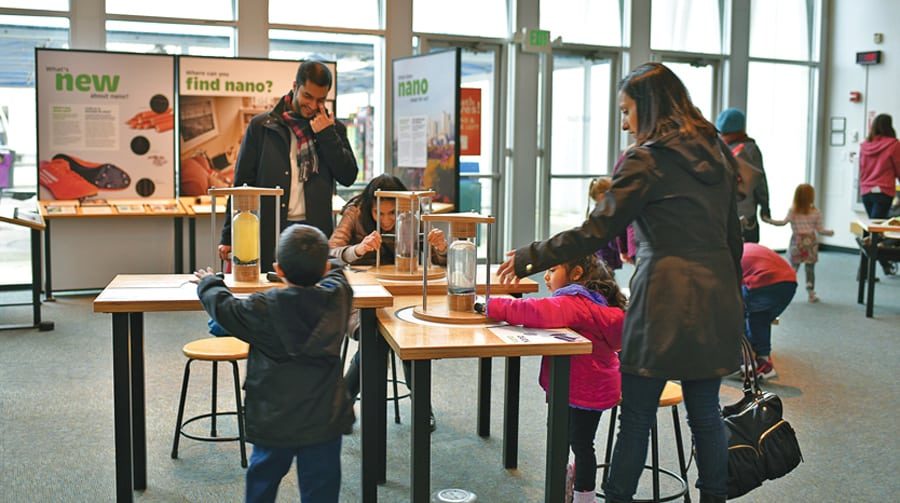
Home » Pacific Science Center ignites the curiosity of the young and the young at heart
Pacific Science Center ignites the curiosity of the young and the young at heart

March 15, 2016
An excited audience watches in awe as a magician pulls a card from a deck. The card, it turns out, is the same one the audience had envisioned in their minds. The power of suggestion, the magician said, coupled with sleight of hand and manipulation, is the science behind magic.
At the Pacific Science Center there is a science behind everything and everything is a science — even, and perhaps most especially — the seemingly unexplainable.
The Pacific Science Center is a playground for the mind, debunking myths, delighting the young and the young at heart, and unlocking the mysteries of the universe.
The Pacific Science Center is at the heart of the Seattle Center, within walking distance of the Space Needle and offering uninterrupted views of the Chihuly Exhibit and public art. The museum has interactive exhibits and hands-on displays, unlocking the mysteries of life sciences, physical sciences and engineering, environmental, and earth sciences, and health and wellness.
Visitors can learn about the science behind sound and music, the explanations on optical illusions, interact with Puget Sound animals and learn about nanotechnology. The museum is so exhaustive in its content visitors are well advised to plan several visits to be able to take it all in.
“A good rule of thumb is to reserve 40 minutes per gallery, but it depends on the visitor,” said Dave Cuomo, Science Interpretation Program Supervisor at the Pacific Science Center.
The Pacific Science Center was initially the U.S. Science Pavilion at the 1962 Seattle World’s Fair. Now it delivers innovative, interactive learning experiences to more than one million guests each year.
“We’re members and for our kids it’s a question of really giving them some interesting science hands-on activities,” said Taylor Felt who works in Seattle for a fine art logistics company. “We really like the exhibits. They’re really well done. We really like the dinosaurs. We also like some of the interactive exhibits dealing with the principles of physics — there is just so much to do and see.”
In addition to the interactive exhibits, there are a ton of fun immersive installations, like Wild Winds, a hurricane simulator that allows you to experience what it feels like to be in the midst of 78 mile-per-hour winds. There are exhibits dedicated to outer space and meteorology and others dedicated solely to bugs and other critters.
Body Works encourages visitors to test muscle endurance, hand-eye coordination, flexibility and visual acuity in an interactive environment that teaches visitors about the mechanics of the human body.
The Pacific Science Center works with local researchers and scientists for its Portal to Current Research, a rotating exhibit that features new scientific research being done locally. Most of the research focuses on memory and the brain, but they may soon add new cutting-edge research.
“In a couple of years we’ll have an exhibit in here that’ll be about astrobiology,” said Cuomo. “We’re working on an astrobiology grant, which focuses on the search for life beyond earth.”
The Pacific Science Center also boasts the newly renovated Boeing IMAX Theater, which features a cutting-edge sound system, 4K laser projectors, and a 60-ft.-by-80-ft. screen. The 3D theater features documentary exploration films about wildlife, nature, outer space, and the human body, as well as feature films currently in theaters, like Deadpool.
Adjacent to the theater is an entire exhibit dedicated to the science behind 3D technology. It features displays that uncover the true application behind tricks of the mind — like leaping lizard, which urges visitors to cover one eye and the other to watch how a static lizard jumps from one side of the image to the other. One interactive display uses a technology that allows you to manipulate a mouse to look at images of the human body.
One of the ‘must-see’ features at the Pacific Science Center is the Laser Dome — the largest and longest-operating domed laser theater in the world, displaying a brilliant choreography of laser effects. Another special feature is the Willard Smith Planetarium where visitors embark on an immersive journey through the solar system and learn about the NASA missions that have travelled through space. To visit the planetarium, you’ll pay an extra $3 per person.
There is also a 4,000-sq.-ft. temperature-controlled tropical butterfly greenhouse. Each week 500 butterflies are imported and released from sustainable rainforest farms in South and Central America, Africa, and Asia.
Volunteers are distributed throughout the museum where kids can work on hands-on activities and art projects related to the exhibits. The museum also had a maker space for children called the Tinker Tank.
“They get to work on a variety of activities, today they’re talking about aerodynamics and building things to that effect,” said Cuomo.
The museum also has featured exhibits that change continuously.
For times, exhibit information, IMAX show listings and for help planning your visit go to www.pacificsciencecenter.org.
Local News
KEYWORDS day trip march 2016




